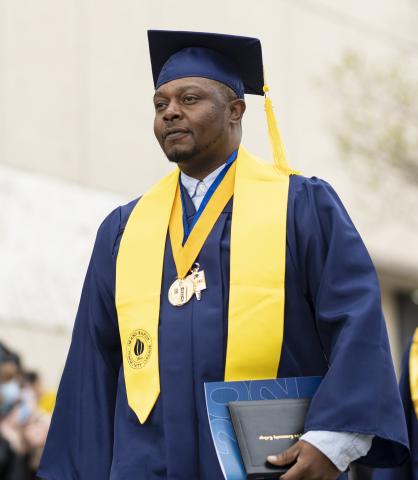
Presidential Chain of Office and Medallion
Dr. Lepper is wearing the presidential chain of office and medallion, which honors past and interim presidents marking the years they have led the institution. The medallion, a copy of the college seal, was crafted by faculty members Mike Merchant, Andy Beach and Nate Spahn using equipment in GRCC’s state-of-the-art manufacturing lab. The design represents the scholarship and authority of the office. The three flames honor the college’s history. These flames exemplify the highest and purest purpose of education in replacing the darkness of ignorance and fear with the vision of truth, understanding and beauty. The college name, embracing the flames, signifies GRCC’s commitment to the highest ideals of wisdom, knowledge and the sacred pursuit of learning.
Academic Mace
Once a familiar weapon in medieval combat, the mace has evolved over time into a symbol of leadership and has become associated with the pride of a nation and its origin. Its presence is a tradition at inaugurations, commencements and academic convocations in institutions of higher learning.
In recent times, the mace was adopted by universities and colleges as a symbol of the power of the academic quest for truth and wisdom. It is carried at academic processions to bring authority to ceremonial occasions and to symbolize the unity and aspirations of the collegial community. The GRCC mace, made by faculty and students, includes a rope of gold encircling the wooden handle that spirals upward emphasizing the strength of the institution. The hardwood column implies strength as it supports and elevates the silver globe – the geometric perfection of endless striving for understanding. Knowledge promises enlightenment and is held in reverence at the pinnacle of the mace. Embedded in the silver globe, the college seal encompasses a global awareness and diversity of the college’s mission.
Academic Regalia
by Eugene Sullivan, American Council on Ed.
Modern academic regalia dates back to the 12th and 13th centuries, when universities as we now know them, were developing. At that time, the majority of students and teachers had taken at least minor religious orders, and accordingly, the form of dress adopted by academics reflected cleric dress of the time. (Education had previously been the preserve of monasteries.)
The gowns of the time would have been long to provide warmth in poorly heated buildings. The style of gowns, and other items, determined by Oxford and Cambridge have provided the basis for academic gowns throughout the British Commonwealth, Eire, South Africa and, to a minor degree, the United States.
The hood had its origin in the tippet, or shoulder covering, worn by begging friars in the early middle ages.
Trencher caps, also known as mortar-boards, are a fairly recent innovation and grew out of the Pileus, a cap worn at Oxford and Cambridge around the 17th century. The square cap of the day grew so large that a board was inserted to prevent the corners from drooping over the eyes. Traditionally, a skull cap was worn beneath the Pileus. The sewing of the skull cap to the Pileus was a marriage of convenience. The tassel was approved by Oxford in 1770.

Delta Pi Alpha
Graduates wearing a medallion on a yellow ribbon, which signifies the Delta Pi Alpha honor recognition, represent the top five percent of the graduating class.
Phi Theta Kappa
Graduates who have achieved a 3.3 cumulative GPA and have joined the Alpha Upsilon Kappa Chapter of Phi Theta Kappa, the international honor society of the two-year college, are identified by a medallion on a blue ribbon.
Honors Program
Graduates identified by the blue, gold and white cords are members of the Honors Program (HP). Graduates wearing a medallion on a white ribbon have completed all Honors Program requirements (HPC).
GRCC Middle College
This partnership between GRCC and participating high schools across West Michigan allows students to earn both a high school diploma and an Associate of Arts degree in four years. Middle College graduates are wearing blue and white cords.
Military Service
Graduates who have served in the United States Armed Forces are identified by the red, white and blue cords.
Promise Zone
Graduates who attended through the Grand Rapids Promise Zone are recognized with purple and white cords.
Stoles
The stole, worn by each graduate, is a gift from GRCC Alumni Relations.
Noorthoek Academy
GRCC celebrates its partnership with Noorthoek Academy, along with its mission of lifelong learning, by recognizing two students with honorary degrees. The academy partners with GRCC to provide a college experience including continuing education and inclusion experiences in the arts and sciences for adults with learning challenges and other intellectual disabilities.
ACADEMIC COLORS

Agriculture - Maize Arts, Letters, Humanities - White
Commerce, Accountancy, Business - Drab
Dentistry - Lilac
Economics - Copper
Education - Light Blue
Engineering - Orange
Fine Arts - Brown
Forestry - Russet
Journalism - Crimson
Law - Purple
Library Science - Lemon
Medicine - Kelly Green
Music - Pink
Nursing - Apricot
Oratory (Speech) - Silver
Pharmacy - Olive
Philosophy - Dark Blue
Physical Education - Sage Green
Public Administration, Foreign Service - Peacock Blue
Public Health - Salmon Pink
Social Work - Citron
Theology - Scarlet
Veterinary Science - Grey